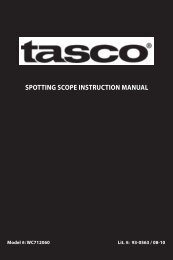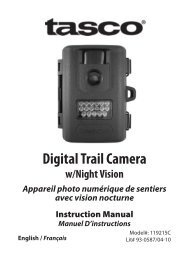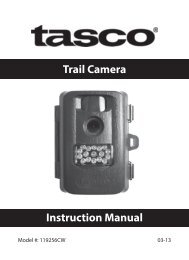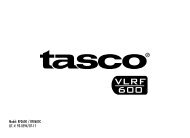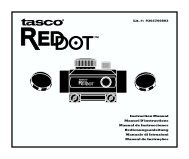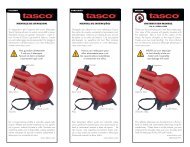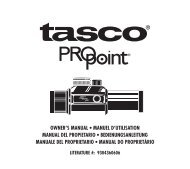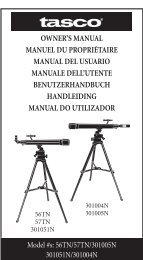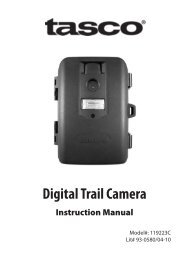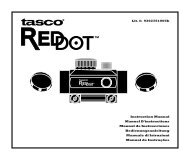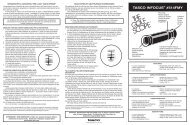owner's manual manuel du propriétaire manual del - Tasco
owner's manual manuel du propriétaire manual del - Tasco
owner's manual manuel du propriétaire manual del - Tasco
You also want an ePaper? Increase the reach of your titles
YUMPU automatically turns print PDFs into web optimized ePapers that Google loves.
BALANCING YOUR TELESCOPE<br />
Precise controls were built into your equatorial mount to hold the telescope steady. When viewing<br />
at high magnifications, even a slight breeze vibrating the body can impair your ability to see<br />
detail. So to stack the cards on your side as much as possible against the limitations of nature, it<br />
is important to balance your telescope (Fig. 15 and 16).<br />
1. Level tripod by adjusting legs.<br />
2. Loosen polar axis clamp and adjust polar axis to correspond to your observing latitude. If you<br />
do not know your latitude, consult a map or atlas. Retighten clamp screw.<br />
3. Loosen declination clamp screw and rotate telescope about the declination axis so that “90 o ”<br />
on the declination scale is aligned with the fixed pointer. Retighten clamp screw.<br />
4. Loosen hour axis clamp, rotate scope until the counter weight rod is in a horizontal position.<br />
Do not tighten clamp screws.<br />
5. If telescope is balanced, it will remain in place.<br />
6. If telescope is out of balance, loosen counter weight thumb screw and slide weight along rod<br />
until telescope remains in place. Tighten weight and hour axis screws.<br />
TO USE THE FINDERSCOPE<br />
The finderscope is a small low-powered and wide field of view telescope mounted alongside the<br />
main telescope and is used to search for the target and aim the main telescope at it (I). Before<br />
you can use the finderscope, youʼll need to line it up with the telescope. This is a simple proce<strong>du</strong>re<br />
once you know how and have practiced a little bit.<br />
1. Install the lowest power eyepiece (20mm) into the eyepiece tube. Pick out an easily recognized,<br />
unmoving object no closer than a thousand yards away. The higher the object is from the<br />
horizon, the easier it will be to position the telescope. Aim your telescope toward your object<br />
until its image is centered in the eyepiece. Lock all the knobs on the equatorial mount so the<br />
telescope will not move.<br />
2. Look through the finderscope. If the object you lined up in the telescope is not visible, loosen<br />
the adjustment screws and move the finderscope around until you see it. Once it gets within<br />
range, tighten the adjustment screws while centering the object in the scope. Youʼll note that<br />
the image will shift toward the screw you are tightening (Fig. 8).<br />
3. Adjust screws to center object on the finderscope cross hairs. Recheck your telescope to make<br />
certain it is still on target. If it moved, realign it and adjust your finderscope. If it hasnʼt, youʼre<br />
all set. Your finderscope is now operational.<br />
TO USE THE STARPOINTER<br />
1. The StarPointer is the quickest and easiest way to point your telescope exactly at a desired<br />
object in the sky. Itʼs like having a laser pointer that you can shine directly into the night sky.<br />
The star pointer is a zero magnification pointing tool that uses a coated glass window to superimpose<br />
the image of a small red dot into the night sky. Like all finderscopes, the StarPointer<br />
must be properly aligned with the main telescope before it can be used.<br />
2. To turn on the StarPointer, rotate the variable brightness control clockwise until you hear a<br />
“click.” To increase the brightness level of the red dot, continue rotating the control knob about<br />
180 o until it stops.<br />
3. Locate a bright star or planet and center it in a low power eyepiece in the main telescope.<br />
If the StarPointer is perfectly aligned, you will see the red LED dot overlap the alignment star. If<br />
the StarPointer is not aligned, take notice of where the red dot is relative to the bright star.<br />
Without moving the main telescope, turn the StarPointerʼs azimuth and altitude alignment controls<br />
until the red dot is directly over the alignment star.<br />
If the LED dot is brighter than the alignment star, it may make it difficult to see the star. Turn<br />
the variable brightness control counterclockwise, until the red dot is the same brightness as the<br />
alignment star. This will make it easier to get an accurate alignment. The StarPointer is now<br />
ready to be used. Remember to always turn the power off after you have found an object. This<br />
will extend the life of both the battery and the LED.<br />
FINDING OBJECTS<br />
1. Look through the StarPointer finderscope and pan the telescope until the object appears in the<br />
field of view. Once itʼs in the field, tighten the altitude and azimuth locks.<br />
2. To center the object with the red dot in the StarPointer, use the fine adjustment ring on the altitude<br />
slow motion rod assembly.<br />
8




